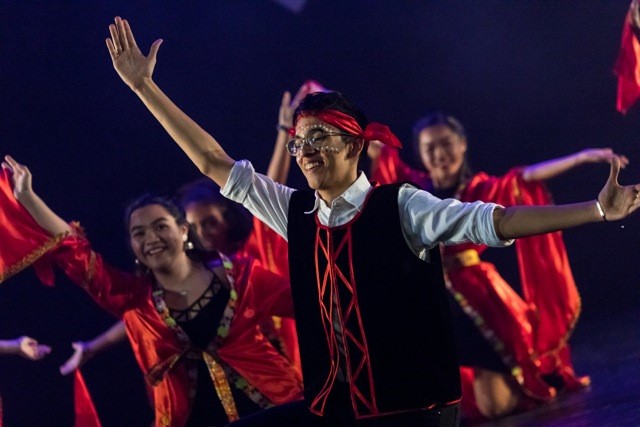CultuRama: Celebrating cultural diversity at UWCSEA through dance
Posted: 01 August 2018

Vice-Principal, Cathy Jones, of UWCSEA shares information on an initiative to help students discover diversity and different cultures through studying dances around the world. Learning is shared in the lead-up to and during a performance event called CultuRama.
Author and position: Cathy Jones, Vice Principal
School: UWCSEA is an international IB school with two campuses in Singapore supporting over 5,500 students, across 90 nationalities, aged 4-18 years.
Introduction
The seed of CultuRama was sown by two Senior School students inspired by a UN show at our sister school. They came to me three years ago with the idea for an event celebrating cultural diversity. As our High School was only two years old at the time, we saw this as a great opportunity to bring our community together, celebrating the diversity of nationalities we serve, and educating the students on the rich and diverse cultural backgrounds we have here at our school and around the world.
After much discussion about what form such a celebration should take, we settled on the concept of CultuRama. CultuRama is an evening event for the whole school community where the students perform dances from around the world. The performance marks the end-point of a learning process which enables the students to understand in greater depth various aspects of the dance including its choreography, music and costumes.
Planning
In our first year, we had to be very pragmatic about the format of the event to ensure its success. So, whilst we explored a lot of ideas to help inform our students about different cultures including music, food, language and games, we settled on just one medium – dance – for simplicity and ease. Once the initiative had built momentum in future years, we were able to incorporate some of our original ideas in a more fluid way. We also simplified the performance element of the initiative. Originally, we had planned a week-long celebration, but on reflection, agreed that two evening performances would be more manageable.
Detailed planning of CultuRama was undertaken by a student committee and each year, these roles are reappointed. The key roles are as follows:
- A student to oversee communication with the dance leaders: this is a vital role, and requires the individual to exercise the strongest communication skills, as emotions can run high when the children are discussing elements of the performance and progress.
- A student to liaise with the parent committee: to organise the catering, which in recognition of the focus on cultural diversity, incorporates food from around the world.
- A student to liaise with the facilities team: to handle the usual aspects of furniture co-ordination, room availability for rehearsals etc.
- A student to oversee tech: particularly the live-streaming element of CultuRama, which allows us to share the performances with a wider audience of alumni and families around the world.
- In addition to the students, we are ably supported by our dance teacher, who coordinates all logistical aspects of the performance, such as the staging and lighting. We also draw upon the expertise of a volunteer teacher to work with the committee to support them on their budgeting. (Income is received from ticket sales which covers our costs.)
- The committee is then bolstered by volunteers from our teaching body and parent community who provide a supporting role for many other aspects.
Activity
The work for CultuRama usually starts in January. At that time, we form the student committee, allocate roles and begin planning our performances.
We invite students to put themselves forward as ‘Dance Leaders’. This role involves the students educating themselves on their chosen dance (in cases, for example, where a student has chosen a dance from another culture) and working with the student volunteers to create their performance. They come to the committee with their idea and must explain to us why they have chosen their dance and what they understand the dance demonstrates about the culture it represents. In previous years, we have enjoyed performing dances from countries including Kazakhstan, Mauritius, Indonesia, Ukraine and Korea.
Once the dance leaders, and therefore cultural dances, have been chosen, we hold auditions for the students to participate in the dances.
With the dance groupings confirmed, the following months involve a lot of work from the students to learn about the background to their dance using research tools such as YouTube. Sometimes dance leaders have had to learn about a culture other than their own and must ensure that what the dance portrays on stage is both accurate and appropriate. There are many hours of research to check steps and routines, or appropriate gestures for men and women, for example, why is it that women cannot participate in a traditional haka, or men use certain steps?
As the CultuRama performance draws closer, we make use of the students’ class tutor time to learn more about the cultures involved in the evening performance. The activities include quizzes, putting together country displays or playing games from some of the countries observed.
Excitement builds ahead of the performance itself (usually in October/November) and it has been thrilling to see the evening event growing year-on-year. One vital part of the evening’s proceedings is the role of the student MCs. After a series of dances (perhaps 3) they will regale the audience with fascinating information on the background to the dances they have just seen, so other students, teachers and parents understand the wider cultural context.
Challenges
- Being culturally sensitive – It was vitally important that we accurately represented and understood the cultures celebrated in CultuRama. We were conscious of the need to avoid interpreting different cultures through our own cultural mores; we had to educate ourselves and immerse ourselves in the different attitudes and thinking that framed the cultures we planned to celebrate. One example of that is the New Zealand ‘Haka’. This is performed by the boys in what may be interpreted as a very aggressive display. We worked hard to ensure that such a dance was not just seen as a novelty show for the boys but represented the dance’s deep cultural roots.
- Focusing on the learning experience, not the show – We work very hard to keep the learning experience paramount in our planning and this very much guides our decisions around the CultuRama performance itself. In another environment and with different objectives, one might make alternative decisions around the performance. The focus on the ‘show’ aspect, or the standards around ‘quality’ might be higher. However, this might entail difficult decisions about how much time should be put into research versus performance rehearsal, or which students should be involved in the show itself. I always champion and support the highest levels of student participation to achieve the widest benefits in terms of learning opportunities. This may well result in a show without quite the gloss and panache displayed by seasoned performers, but that decision has reaped rewards in terms of the students’ learnings and enthusiasm for the initiative.
- Keeping the initiative student-led – As CultuRama has grown in our school, it has created a lot of ideas and enthusiasm from all parties. There is a risk that such enthusiasm bubbles over and the students’ ideas and interests get lost. I always emphasise that this is a student-led project and let them take the lead on key decisions.
Impact
Using the medium of dance to discover a new culture has provided an inspiring in-road into many new cultures for our students. Through learning the steps, hearing the music and considering the costumes, we learn many things about cultural traditions, for example, what is the meaning behind the use of a scarf, or the style of a dress or mask? The students learn new skills, acquire new knowledge, develop a deeper international understanding and connect with our community.
As an audience member, CultuRama has been an invaluable reminder of the mosaic of our humanity. The expression of culture through dance often shows us something of the geography, history and beliefs of people across the world. Whilst celebrating such diversity, we also recognise the connections between cultures, showing how we have influenced each other through migration, colonisation, assimilation and proximity.
Through planning what became CultuRama, we recognised an opportunity for students to not only learn about one another and themselves, but also to learn and develop through the very process of organising and executing a large-scale community event. As CultuRama has grown over the past three years, so has our understanding of the many ways in which students learn through the experience. It is difficult to find a skill or quality that is not addressed through participating in CultuRama. There are the obvious ones—creativity, collaboration and communication seem to be intrinsic—but resilience, self-awareness and self-management are essential too, when you have many hours of rehearsal while juggling academics, other activities and service.
In the end, the most valuable aspect of CultuRama has been the learning that students gain through their efforts to build a unifying community event. With many High School students involved in one way or another, with teachers, administrative and facilities staff supporting, and with parents participating, it has become a tradition that brings us together while learning to appreciate each other’s differences.
Being able to observe such a joyous performance is a wonderful illustration of our students’ skills and holistic education.
In terms of scale, it has been heartening to see the growth of enthusiasm for CultuRama and whilst we have not undertaken any formal evaluation research, we are delighted to have seen a growth in students wishing to become involved (over half of our students are involved in some way) and also students returning year-on-year eager to learn about a new culture.
The future
The students are keen to expand their interest in this area and we are currently discussing the possibility of having a ‘language week’.
Advice
- Be clear on your purpose – This will help you make the necessary decisions around key aspects such as how students participate, what roles they perform, how the evening performance is designed and how the initiative is judged by others.
- Be clear about the criteria of selecting students, and stick to that – Linked to the above, this may involve selecting students who may not deliver the most polished dance performance on the night, but perform with every ounce of their being. This may involve going beyond the usual candidates to allocate a role to an individual student who may benefit more from the learning experience.
- Don’t strive for perfection! You will always wish to change and adapt things, that is part of the learning process. It’s important to remember that you learn so much from engaging with others, sharing ideas and collaboratively making decisions. That is more important that a perfect production.
